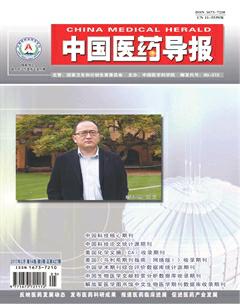结直肠癌局部免疫动物模型研究进展
秦凯迪++++++童仕伦++++++郑勇斌++++++孙伟++++++肖旷++++++宋丹
[摘要] 构建结直肠癌的动物模型在研究人类结直肠癌的预防与治疗中具有重大意义,而研究肿瘤的发生、发展及转移中扮演重要角色的癌组织局部免疫状态的动物模型尚处于探索阶段。其中局部免疫基因工程模型的研究发展迅速,并在突变结肠干细胞成瘤以及解决因原发肿瘤生长而导致的肠梗阻上取得了突破性进展。由此,一种未来理想局部免疫基因工程模型已展露雏形。
[关键词] 结直肠癌;局部免疫状态;基因工程小鼠模型;结肠干细胞
[中图分类号] R656 [文献标识码] A [文章编号] 1673-7210(2017)02(b)-0028-03
[Abstract] The establishment of animal models of colorectal cancer in the study of human colorectal cancer prevention and treatment has great significance, and the study of tumor occurrence, development and metastasis which plays an important role in the local immune status of cancer animal model is still in the exploratory stage. The study of local immune genetic engineering model has developed rapidly and has made breakthrough progress in mutating colonic stem cell and solving intestinal obstruction caused by primary tumor growth. Thus, an ideal local immune genetic engineering model has been exposed prototype.
[Key words] Colorectal cancer; Local immune status; Genetic engineering mouse model; Colon stem cells
结直肠癌目前已是全世界第二大高致死率的肿瘤[1]。其癌细胞的产生与转移、机体内外多种因素相关,而癌组织的局部免疫状态在其中发挥的重要作用越来越得到学者的重视。最初研究结直肠癌的局部免疫状态的资料多来源于临床手术标本,但它的局限性也是显而易见的,如受人体的医学伦理学限制取材缺乏可重复性以及因切除标本多为中晚期肿瘤而缺乏广泛代表性等。后来学者的研究重点放到了小鼠模型上,现有的结直肠癌小鼠模型根据成瘤机制不同可分为三种:其中一种是运用致癌剂诱变细胞成瘤;另外一种是直接移植肿瘤细胞进而使小鼠成瘤;最后一种就是运用基因工程方法使小鼠成瘤,其中基因工程学小鼠模型研究发展迅速。三种模型各有优缺点,但现阶段终究都不是理想的结直肠癌的局部免疫研究模型。未来理想的结直肠癌动物模型要满足两个要求:一方面人体结直肠癌病理生理过程可通过反复无损伤取材而被模型重现并全程监测,另一方面小鼠免疫功能不被人为原因破坏,满足局部免疫研究要求。本文将阐述结直肠癌与局部免疫状态的关系、回顾现有的结直肠癌局部免疫动物模型和讨论理想的局部免疫动物模型研究进展。
1 结直肠癌局部免疫动物模型必要性
肿瘤特别是结直肠癌的发生、发展、转移是个复杂而缓慢的过程,病灶局部免疫状态在其中发挥重要作用。通常状态下,一方面,人体免疫系统能够及时识别体内突变细胞并加以消灭,另一方面,研究表明,肿瘤细胞可以逃避免疫系统的识别和杀伤[2-3]。虽然其具体逃避机制尚不明确,但是大量的临床研究表明,肿瘤细胞可与其局部免疫状态之间发生某些适应性改变如免疫逃逸和免疫抑制,躲避人体免疫系统的负性调节,从而造成肿瘤细胞进一步的发生、发展及转移[4-6]。
具体来说,由于人体对肿瘤组织的免疫反应是个多环节、多影响因素的复杂病理生理过程,既包括先天性免疫系统的作用,又包括获得性免疫系统的影响。在肿瘤产生阶段,个体差异决定了其免疫系统功能强弱的不同,造成某些情况下肿瘤细胞发生时免疫系统不能将其及时识别及消除,从而形成肿瘤原发灶。在肿瘤转移阶段,肿瘤细胞可通过某种机制逃脱免疫监视,随人体体液系统到达新定植点,新定植点局部免疫系统将与癌细胞发生繁琐的互相适应性改变,甚至其病灶局部免疫细胞种类都会发生变化,从而使转移灶形成和生长[7-11]。如乳腺癌转移时,转移器官如肺的局部免疫功能会被肿瘤细胞降低,这样转移来的癌细胞将得到一个合适的定植环境,从而促进乳腺癌细胞肺转移病灶的形成与生长[12]。
这些发现均提示机体局部免疫状态和结直肠癌的发生和发展关系密切,而合适的结直肠癌局部免疫动物模型是现阶段此领域发展的基础和热点。
2 当前结直肠癌局部免疫小鼠模型比较
近些年,结直肠癌小鼠模型发展迅速,现有的结直肠癌小鼠模型根据成瘤机制不同可分为三种。
第一类模型即致癌剂诱变小鼠模型:这种模型通过特定致癌剂直接作用于动物细胞从而诱发其发生细胞突变,但其并不适合成为现阶段理想的结直肠癌局部免疫动物模型,这是因为一方面,现阶段已知的致癌剂诱发活体动物细胞癌变的发生率低且不可预测,诱发后成瘤周期也较长;另一方面,致癌剂不可避免地带来诸多副作用,常常造成机体的免疫功能损伤。
第二类模型即癌细胞原位或异位移植小鼠模型:它是在活体动物机体中直接原位或异位移植肿瘤细胞,通过移植肿瘤细胞自身的生长而成瘤,这类模型又可分为异基因系小鼠移植模型及同基因系小鼠移植模型两大类:前者因為受体免疫系统可识别及杀伤移植细胞,要想成瘤常常需抑制受体动物的免疫功能,这种局限性严重限制了其在结直肠癌局部免疫状态领域的应用;后者则避免了免疫排斥的缺点,如有研究者通过外科手术将小鼠结肠癌细胞系注入另外一种小鼠体内,试图形成小鼠结肠癌转移模型并研究其免疫功能变化[13]。但此类模型仍有不足,首先,这类模型无法避免手术这一有创操作对受体动物的免疫功能的影响;其次,模型肿瘤组织取材也需通过手术操作甚至处死动物,不能反复多次取材,从而对肿瘤病程监测缺乏连贯性,阻碍了此类模型的发展。
第三類模型即基因工程小鼠模型:它是通过基因打靶、基因沉默和转基因等基因工程技术产生基因剔除、转基因疾病小鼠模型和基因功能研究模型,最初的基因工程型模型由于生命周期短及基因技术严重影响机体免疫功能而很少应用于局部免疫学研究[14],随着能使动物基因选择性“湮灭”的基因工程方法出现,此类模型取得了突破性的进展,如有研究者将远端结肠上皮内APCloxP等位基因特异性敲除,从而形成理想的散发性结肠癌模型[15]。但是,不能监测肿瘤发生早期局部免疫状态的不足,限制了该模型的应用。
3 局部免疫基因工程模型的研究突破
现阶段结直肠癌局部免疫基因工程模型的突破性进展来源于通过基因工程技术突变结肠干细胞成瘤以及突变成瘤后原发肿瘤生长导致肠梗阻的解决这两个方面。
具体来说,首先,研究表明,在正常情况下,小鼠隐窝基底部干细胞的分裂与结肠细胞的凋亡处于动态平衡,动态平衡的打破将导致腺瘤形成[16]。敲除Apc基因的小鼠,腺瘤发生概率大,且常会癌变[17];当结肠干细胞的Kras基因被突变后,其腺瘤常向腺癌轴向发展[18-19]。当Apc基因和Kras基因同时发生变化时,原发癌灶常会形成并合并自发性转移灶[20]。而且,现阶段已有研究者通过特异性激活小鼠结肠干细胞内的特殊颜色基因来标记干细胞,通过研究单个干细胞的增殖,进而说明肿瘤的发生与转移。这些都说明可以通过突变干细胞研究肿瘤的发生转移过程[21-22]。
在此基础上,由于突变结直肠干细胞成瘤后,结直肠癌发生与转移需很长时间,小鼠常因肿瘤生长导致的肠梗阻死亡。近些年,小鼠结肠镜的研究进展为局部肠梗阻的解决提供了条件,通过小鼠结肠镜研究者在镜下可反复将扩张支架置于狭窄肠管处或切除部分肿瘤组织使其恢复到通畅状态[23-25]。模型小鼠的研究时限将被延长,更有利于转移灶的形成,从而为全程监测小鼠局部免疫状态提供了基础。
4 一种理想的局部免疫基因工程模型展望
根据现阶段局部免疫基因工程模型的研究进展,参照国外学者对单个干细胞标记的方法,可尝试通过基因工程学方法,使小鼠Apc基因和Kras基因同时发生变化并特异性突变且标记结肠干细胞使其成瘤,并在肿瘤的发生和转移过程中,随时通过小鼠结肠镜和活体显像系统监测目标干细胞的肿瘤病理生理过程并同时解决肠梗阻状态,最终构建具有以下特点的一个理想的局部免疫研究模型:①目标突变结肠干细胞能被特异性示踪,进而动态监测肿瘤的发生、转移全过程,构建其肿瘤病理生理过程满足人体腺瘤-腺癌-转移发展规律的动物模型;②可通过非手术的方式对癌周组织反复取材,并能避免肿瘤生长迅速导致肠梗阻造成的不良结局;③在研究全过程中动物免疫功能保持健全。
此模型将在研究结直肠癌的发生、发展、转移等过程与机体免疫系统的相互关系上发挥重要作用。
[参考文献]
[1] Wu PF,Zhang F,WANG F,et al. Natural compounds from traditional medicinal herds in the treatment of cerebral ischemia/reperfusion injury [J]. Acta Pharmacal Sin,2010, 31(12):1523-1531.
[2] Okada N,Sasaki A,Niwa M,et al. Tumor suppressive efficacy through augmentation of tumor-infiltrating immune cells by intratumoral injection of chemokine-expressing adenoviral vector [J]. Cancer Gene Ther,2006,13(4):393-405.
[3] Hamanishi J,Mandai M,Abiko K,et al. The comprehensive assessment of local immune status of ovarian cancer by the clustering of multiple immune factors [J]. Clin Immunol,2011,141(3):338-347.
[4] Tosolini M,Kirilovsky A,Mlecnik B,et al. Clinical impact of different classes of infiltrating T cytotoxic and helper cells(Th1,th2,treg,th17)in patients with colorectal cancer [J]. Cancer Res,2011,71(4):1263-1271.
[5] Nakanishi M,Menoret A,Tanaka T,et al. Selective PGE2 suppression inhibits colon carcinogenesis and modifies local mucosal immunity [J]. Cancer Prev Res(Phila),2011, 4(8):1198-1208.
[6] Bindea G,Mlecnik B,Fridman WH,et al. Natural immunity to cancer in humans [J]. Curr Opin Immunol,2010,22(2):215-222.
[7] Ritsma L,Ellenbroek SI,Zomer A,et al. Intestinal crypt homeostasis revealed at single-stem-cell level by in vivo live imaging [J]. Nature,2014,507(7492):362-365.
[8] Qi Z,Chen YG. Regulation of intestinal stem cell fate specification [J]. Sci China Life Sci,2015,58(6):570-578.
[9] Walther V,Graham TA. Location,location,location!The reality of life for an intestinal stem cell in the crypt [J]. J Pathol,2014,234(1):1-4.
[10] R?觟cken M. Early tumor dissemination,but late metastasis:insights into tumor dormancy [J]. J Clin Invest,2010, 120(6):1800-1803.
[11] Grotz TE,Mansfield AS,Jakub JW,et al. Regional lymphatic immunity in melanoma [J]. Melanoma Res,2012, 22(1):9-18.
[12] Yan HH,Pickup M,Pang Y,et al. Gr-1+CD11b+ myeloid cells tip the balance of immune protection to tumor promotion in the premetastatic lung [J]. Cancer Res,2010,70(15):6139-6149.
[13] Grimm M,Gasser M,Bueter M,et al. Evaluation of immunological escape mechanisms in a mouse model of colorectal liver metastases [J]. BMC Cancer,2010,10:82.
[14] Velázquez KT,Enos RT,Narsale AA,et al. Quercetin supplementation attenuates the progression of cancer cachexia in ApcMin/+ mice [J]. J Nutr,2014,144(6):868-875.
[15] Hung KE,Maricevich MA,Richard LG,et al. Development of a mouse model for sporadic and metastatic colon tumors and its use in assessing drug treatment [J]. Proc Natl Acad Sci USA,2010,107(4):1565-1570.
[16] Strilbytska OM,Semaniuk UV,Storey KB,et al. Activation of the Tor/Myc signaling axis in intestinal stem and progenitor cells affects longevity,stress resistance and metabolism in drosophila [J]. Comp Biochem Physiol B Biochem Mol Biol,2017,203:92-99.
[17] Krausova M,Korinek V. Wnt signaling in adult intestinal stem cells and cancer [J]. Cell Signal,2014,26(3):570-579.
[18] White AC,Tran K,Khuu J,et al. Defining the origins of Ras/p53-mediated squamous cell carcinoma [J]. Proc Natl Acad Sic USA,2011,108(18):7425-7430.
[19] Qiu W,Tang SM,Lee S,et al. Loss of activin receptor type 1B accelerates development of intraductal papillary mucinous neoplasms in mice with activated KRAS [J]. Gastroenterology,2016,150(1):218.e12-228.e12.
[20] Hardiman KM,Liu J,Feng Y,et al. Rapamycin inhibition ofpolyposis and progression to dysplasia in a mouse model [J]. PLoS One,2014,9(4):e96023.
[21] Snippert HJ,van der Flier LG,Sato T,et al. Intestinal crypt homeostasis results from neutral competition between symmetrically dividing Lgr5 stem cells [J]. Cell,2010,143(1):134-144.
[22] Lopez-Garcia C,Klein AM,Simons BD,et al. Intestinal stem cell replacement follows a pattern of neutral drift [J]. Science,2010,330(6005):822-825.
[23] Zigmond E,Halpern Z,Elinav E,et al. Utilization of murine colonoscopy for orthotopic implantation of colorectal cancer [J]. PLoS One,2011,6(12):e28858.
[24] Bettenworth D,Mücke MM,Schwegmann K,et al. Endoscopy-guided orthotopic implantation of colorectal cancer cells results in metastatic colorectal cancer in mice [J]. Clin Exp Metastasis,2016,33(6):551-562.
[25] Bhullar JS,Subhas G,Silberberg B,et al. A novel nonoperative orthotopic colorectal cancer murine model using electrocoagulation [J]. J Am Coll Surg,2011,213(1):54-60.

